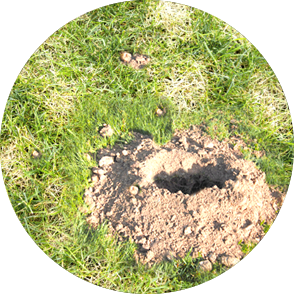Ground Hog Damage Identification
Understanding Groundhogs and the Damage they Can Cause.
Groundhogs: Damaging Above Ground—and Below
Groundhogs, also known as woodchucks or whistling pigs, are members of the squirrel family and are a thorn in the side of many a gardener. They are solitary, herbivorous hibernating mammals, and eat almost every type of green plant.
Groundhogs live in burrows that can have more than one entrance, and and you can easily identify their burrows by the mounds of excavated dirt alongside entrances. Their burrow holes and dirt mounds hinder farm equipment and can pose a threat to horses and livestock.
How to Identify Groundhog Damage
Since you won’t often catch them in the act of devouring your garden, it may be difficult to identify a groundhog as the culprit. Groundhogs consume grasses, clover, garden vegetables, leaves, twigs, apples, berries, and dandelions. In your garden, the groundhog will seek beans, peas, herbs, strawberries, pansies, and impatiens. Damage to fruit and ornamental trees is caused by gnawing for scent marking or wearing down the winter growth of their teeth and by clawing to sharpen their claws. If underground cables show chewing damage upon inspection, you may have a groundhog living under your property.
In order to reduce the chances of having to deal with groundhogs, clear areas that have tall grass, tall weeds or brush piles; these will only serve as cover for them, from which they can launch attacks upon your garden. These timid animals may never take up residence near your garden in the first place if sufficient cover is lacking.
Other Signs of Groundhogs
You may want to look for tracks left behind by the culprit ravaging your gardens. Groundhog tracks, spaced 4 to 12 inches apart, are easy to spot. Look for paw imprints with four toes on the front paws and five toes on the back with one set lower than the rest. Curved claws on their front paws make for easy burrowing. Both the front and back prints will have with sharp claws on the ends of each toe. You should see the front paw track immediately followed by the rear track. Groundhogs normally defecate in toilet chambers they dig underground. Their scat appears as round to oval pellets.
Bobbex-R Repellent to the Rescue
Bobbex-R naturally repels Ground Hogs, detering them from plants, gardens, and saving potentially costly damage.
Your 100% Satisfaction is our Top Priority!
If you are not satisfied with this product, Bobbex Inc. will refund the suggested retail price or replace it with an item of equal value. Proof of purchase required.

